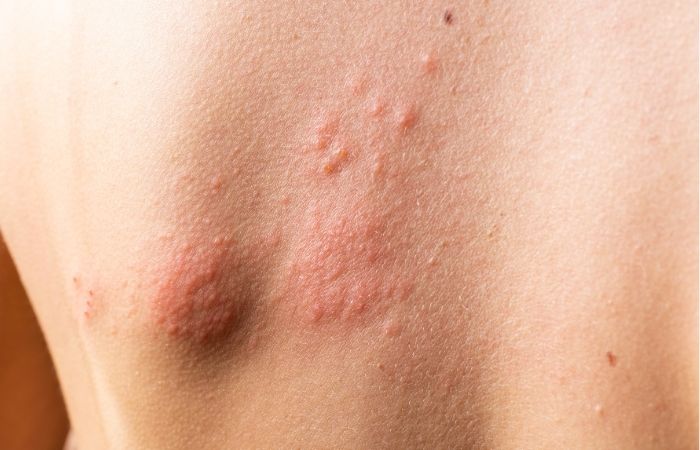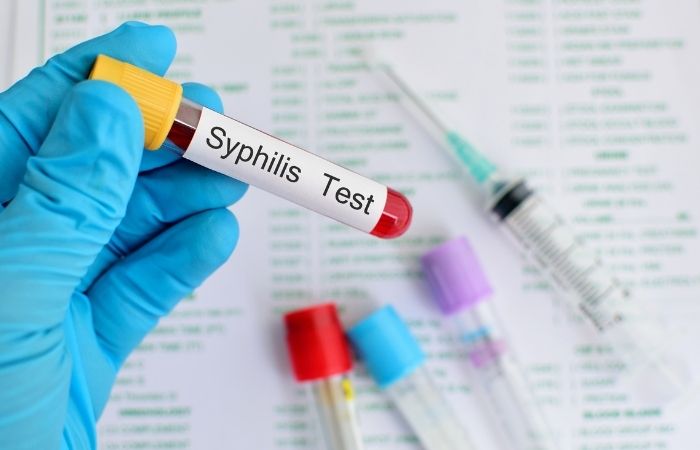Is Oral Sex Safe? Why You Can Still Catch STDs Without Penetration
Quick Answer: A syphilis sore often looks like a firm, round bump that doesn't hurt or itch, making it easy to confuse with bug bites, ingrown hairs, or pimples. If a bump won’t go away after 1–2 weeks, or if it appears after unprotected sex, it’s time to get tested.
It Doesn’t Hurt, So It Can’t Be an STD… Right?
This is one of the most dangerous assumptions people make. Because syphilis doesn’t always behave like an “obvious” STD.
In its first stage, syphilis often shows up as a small, firm sore, usually round, usually painless, and often mistaken for something harmless. If it’s in a hidden area like under the foreskin, on the anus, or inside the mouth, it might not get noticed at all. But here’s the problem: this sore, called a chancre, is highly contagious. And just because you can’t feel it doesn’t mean it’s not a threat.
According to the CDC, the average incubation period for syphilis is 21 days. That means the sore can show up weeks after exposure, long after the hookup is over and your mind has moved on. During this window, people often think they’re in the clear. But the chancre is doing its work: multiplying the bacteria in your system and passing it on through skin-to-skin contact.
That’s why syphilis is called “the great imitator.” It pretends to be everything else, then disappears just as quietly as it came. If untreated, the sore heals on its own after 3 to 6 weeks. And that’s when people think they’re cured. But inside the body, syphilis is leveling up to its next stage.

People are also reading: Scared to Have Sex Again After an STD? Here’s the Real Talk You Need
What a Syphilis Sore Actually Looks Like
There’s a reason people mistake syphilis for razor burn or a bug bite: it doesn’t always look scary. In fact, many people say it looks “clean.” No pus. No swelling. No crusting. Just a firm, red or dark-pink sore, sometimes flat, sometimes slightly raised. It may appear solo or as a small cluster, depending on where it is. Genital sores are most common, but oral or anal chancres are becoming more reported in queer and oral-sex-forward populations.
Here’s what sets it apart: it doesn’t hurt. Not even a little. And that’s exactly why it gets ignored. Compare that to herpes (which usually stings or burns) or pimples (which can throb or swell). Syphilis keeps quiet until it doesn’t.
Table 1: How syphilis sores compare to other common bumps
“I Thought It Was Just Razor Burn”
Casey, 25, shared how she almost missed her diagnosis: “I shave with a single blade and always get bumps around my bikini line, so I didn’t think twice about it. But this one didn’t go away. It was just… there. No pain. No change. I finally got it checked, and boom, syphilis.”
She’d been dating someone new. They used condoms, but not during oral. “I didn’t even know you could get syphilis from oral sex,” she says. And she’s not alone. A 2023 review published in The Lancet Infectious Diseases confirmed that oral sex is a significant and rising route of syphilis transmission, especially in populations under 30.
That’s why visual inspection isn’t enough. You can’t tell someone’s status by looking. And you can’t trust that a bump is “just a bump” if you’ve had new partners, especially without testing. Whether it’s friction, shaving, or a summer mosquito, if it sticks around longer than 7–10 days, it’s worth checking out.
What Happens If You Miss the First Sore?
Here’s the kicker: that first bump, the chancre, goes away. It heals without medicine. No scab, no scar, no drama. And when that happens, most people think the problem’s over. But beneath the surface, syphilis is still doing damage.
If untreated, syphilis progresses into its second stage, and this time, it doesn’t play nice. Instead of one sore, you get a spread of symptoms across your whole body. We’re talking rash on the palms of your hands and soles of your feet, flu-like symptoms, swollen lymph nodes, fatigue, patchy hair loss, and even mouth ulcers. Some people call it the “phantom flu.” Others just feel off, and they don’t always connect the dots.
Think about how easy it is to misread that. A rash on your hands? That could be anything. Sore throat and headache? Maybe it’s just a cold. By the time secondary syphilis shows up, weeks or even months may have passed since the original bump, and most people aren’t tracking symptoms that far back. That’s how this infection keeps slipping through the cracks.
The scary part? Even in this second stage, symptoms can fade without treatment. But syphilis doesn’t disappear. It just goes underground, into the latent stage, where it hides in your body, sometimes for years. And for about 30% of people who never treat it, it eventually turns into tertiary syphilis, where it attacks your brain, heart, eyes, and nerves. Yes, in 2025, that’s still a thing.
Table 2: Syphilis stages, symptom timeline, and transmission risk
“Why Didn’t Anyone Catch This Sooner?”
Rae, 41, spent six months chasing fatigue and weird skin issues before anyone even suggested an STD test.
“I went to urgent care three times,” they said. “The rash was misdiagnosed as eczema. The hair loss? My doc thought it was stress. No one asked about my sex life until I asked for bloodwork.”
When the test came back positive for syphilis, Rae was furious, not just at the system, but at themselves. “I’d Googled everything except the right thing. I just never thought I could have syphilis. That’s how well it hides.”
This story isn’t rare. Primary and secondary syphilis are frequently misdiagnosed, especially in women, queer folks, and people of color. According to a 2022 study in Clinical Infectious Diseases, syphilis continues to be under-recognized in non-penile presentations, including oral, anal, and dermal lesions, leading to treatment delays and preventable complications.
That’s why a visual check won’t cut it. You can’t see syphilis in a mirror or diagnose it from memory. You need a test, and the sooner, the better.
How to Test for Syphilis (Yes, Even at Home)
The good news? You don’t need to wait until a sore shows up to get answers. Syphilis can be detected with a simple blood test, even if you don’t have symptoms. That means you can get tested during a “what if” moment instead of waiting for something to appear. Testing early also means earlier treatment, which reduces your risk of complications and stops the spread to others.
And yes, you can do it at home. At-home syphilis tests work by detecting antibodies to the Treponema pallidum bacteria. They’re fast, accurate, and private, perfect if you’re not ready to hit up a clinic yet. Many people use them between partners, after a risky encounter, or just for peace of mind during outbreak scares.
If your test is positive, you’ll need to follow up with a provider for treatment. The standard therapy is a single injection of penicillin G benzathine, which clears the infection and stops transmission. If you’re allergic to penicillin or late in the disease, the treatment might vary, but syphilis is almost always curable when caught early.
Testing isn’t just about finding out, it’s about taking back control. If you’ve had new partners, unprotected oral sex, or suspicious bumps that don’t go away, test. If your gut says something’s off, test. Even if you’re just anxious and unsure, test. There’s no shame in checking. Only clarity.

People are also reading: Should You Wait to Have Sex Until STD Results Are In?
Syphilis vs Everything Else: The Bump Breakdown
If you’ve ever stood in front of a mirror, tugging skin and Googling “STD or razor burn?”, congrats, you’re not alone. One of the biggest reasons people delay treatment is because syphilis doesn’t scream “emergency.” It whispers. And it looks a lot like other things you’ve probably seen on your body before.
Here’s where it gets messy: Syphilis, herpes, razor burn, and even folliculitis can show up in the exact same spots, groin, thighs, labia, penis shaft, anus, mouth. And they all tend to appear right after sex, when friction, shaving, and heat are in full play. So how do you know when to freak out and when to moisturize?
The key isn’t panic, it’s pattern recognition. Where’s the bump? Is it alone or part of a group? Does it hurt? Is it changing? Is it stubborn? And, most importantly, did you have any new sexual contact in the last month? If the answer’s yes and the bump hasn’t resolved in a week or two, it’s time to stop guessing.
Table 3: Commonly confused skin issues vs actual syphilis
“I Swore It Was Just a Pimple”
Marcus, 29, found a spot right on the shaft of his penis. “It looked like a zit. Dead serious. I even tried to pop it,” he laughs. “It didn’t pop. It didn’t hurt. It just sat there.” Three weeks later, he had a rash on his palms and thought it was detergent allergy. When a provider finally tested him, his syphilis titer came back sky-high. “It was so frustrating. I had no idea a pimple-looking bump could turn into all that.”
This is where visual assumptions break down. We’ve been taught to look for oozing, pain, swelling, but syphilis doesn’t follow those rules. It’s clean. Quiet. And stubborn. If you’ve ever been told, “If it doesn’t hurt, it’s not an STD,” you’ve been fed a myth.
Okay, But What If I Don’t Have a Bump At All?
Fair question. Not everyone gets the classic chancre. In fact, some people’s sores are so small or internal they never notice them at all. Others get symptoms later in the secondary stage, rash, swollen lymph nodes, fatigue, but never connect them to a past sexual encounter.
This is especially common with oral or anal syphilis, where the sore may be inside the mouth or rectum. If you don’t feel pain, and you’re not actively checking those spots, you could easily miss it. That’s why testing based on risk, not just symptoms, is so important.
If you’ve had unprotected sex in the last 90 days and notice any of the following:
- Bump or sore that doesn’t hurt
- Rash on palms or soles
- Hair thinning in patches
- New fatigue or swollen lymph nodes
…it’s worth checking for syphilis, even if you feel okay.
Testing helps you rule things out. And if you catch syphilis early, you’re cured with one shot. Miss it, and you could carry the infection silently for years.
You Can’t Google Your Way Out of This
Let’s be real: late-night Googling feels productive. You find pictures. You check forums. You spiral a little. But no image match, Reddit thread, or WebMD rabbit hole can give you the one thing you actually need: a diagnosis.
Testing isn’t scary. What’s scary is the damage that happens when we don’t. At-home syphilis test kits are fast, private, and can be ordered in minutes. Results come back quickly, and if you test positive, you’ll have a starting point for treatment that works. You’re not stuck. You’re not dirty. You’re not doomed. You’re just informed.
FAQs
1. Can I get syphilis from oral sex?
Yes, and it's more common than you think. Syphilis doesn’t care if it’s oral, anal, or vaginal—it just needs skin-to-skin contact with a sore. That means even if everything “felt safe,” a tiny, hidden sore in someone’s mouth or throat can pass it on. No condom? Higher risk. Even with one, oral sex still isn't risk-free.
2. Do syphilis sores always hurt?
Nope. That’s the trap. They usually don’t hurt, itch, or bleed. A syphilis sore is like the quiet kid in the back of the classroom—easy to miss, but it’s still there. It might look like a pimple, bug bite, or nothing at all. If you’re waiting for pain to be your red flag, syphilis will sneak past you every time.
3. What if the sore disappeared on its own?
That’s exactly what syphilis does—it disappears and lets you think you’re fine. But while the sore fades, the bacteria spreads. It's not over. It’s just moving to the next round: rash, flu-y symptoms, hair loss, and more. You can’t self-diagnose by disappearance. You need a test.
4. Is one bump really that serious?
Honestly? It can be. If that bump is painless, persistent, and showed up after unprotected sex (especially oral), it’s worth checking. Sure, it might be an ingrown hair—but if it’s syphilis, catching it now saves you months (or years) of silent damage. One bump is all it takes to get or pass on the infection.
5. Can syphilis be cured?
Yes—completely. A single shot of penicillin G is usually enough if caught early. If you’re allergic or in a later stage, there are other options, but yes, this is one STD that has a straightforward cure. The key is not waiting too long to get it.
6. How long after sex does a syphilis sore appear?
On average, about 3 weeks—but it can show up as early as 10 days or as late as 90. That’s why people often don’t connect the dots. They assume they're in the clear because it’s been “a while.” But that sore showing up weeks later? It’s still from that one night.
7. What does a syphilis sore feel like?
Strangely... nothing. That’s part of the reason it gets ignored. Most people describe it as a smooth, firm bump—no pain, no tingle, no oozing. Just “there.” If you’re used to acne or herpes outbreaks that hurt, this one feels suspiciously silent.
8. I checked, and I don’t see anything. Could I still have syphilis?
Yes. Not everyone sees a sore, especially if it’s internal—like inside the mouth, rectum, or vaginal canal. Some people skip right to the second stage (with rashes and weird fatigue) and never realize they had the first sign. That’s why testing matters more than what you can see.
9. Can I test at home without going to a clinic?
Absolutely. At-home syphilis tests are discreet, fast, and legit. You’ll use a small blood sample (finger prick), and results come quickly. No awkward questions. Just answers.
10. Is it embarrassing to get tested for syphilis?
Only if you believe the stigma. But here’s the truth: syphilis is rising across all age groups, genders, and orientations. This isn’t a “reckless” person problem—it’s a human one. Testing doesn’t mean you messed up. It means you care enough to stay healthy and informed.
You Deserve Better Than Guessing
If there’s one thing we want you to take away from all this, it’s that you’re not ridiculous for wondering. You’re not paranoid for staring at a bump. You’re not broken for needing reassurance. You’re human. And syphilis thrives in silence and shame. When you bring it into the light, it loses power.
Whether it’s a sore that won’t heal, a rash that feels off, or just a hunch, you have every right to get clarity. You’re not “overreacting.” You’re advocating for your body. And you’re not alone.
How We Sourced This Article: We combined current guidance from public health institutions, peer-reviewed studies, and community-reported experiences to create a guide that’s clear, compassionate, and medically sound. Around fifteen reputable sources shaped this piece; below, we’ve highlighted some of the most reader-relevant references.
Sources
1. WHO – Herpes Simplex Virus Fact Sheet
2. Planned Parenthood – Herpes 101
3. NEJM – Syphilis in the Modern Era
4. Syphilis — Symptoms & Causes | Mayo Clinic
5. Genital Herpes — Symptoms & Causes | Mayo Clinic
6. CDC Treatment Guidelines for Genital Herpes
About the Author
Dr. F. David is a board-certified infectious disease physician with a specific interest in STI education within a community setting. As a doctor, he has more than 20 years of experience in this field. This experience gives him a wide range of knowledge to share with his readers.
Reviewed by: Dr. E. Thao, MPH | Last medically reviewed: November 2025
This article is for informational purposes only and does not replace professional medical advice, diagnosis, or treatment.






